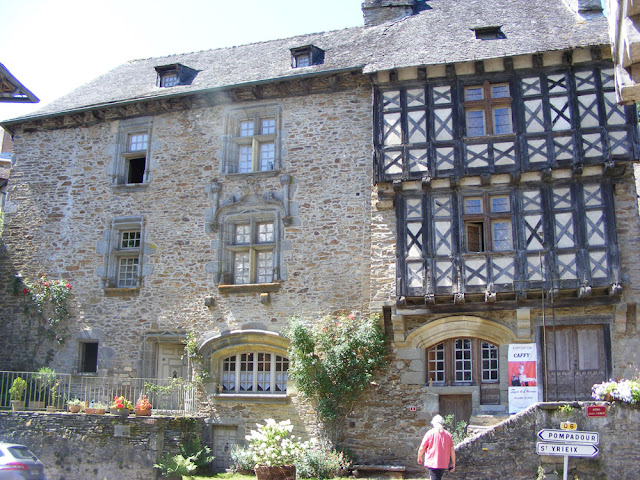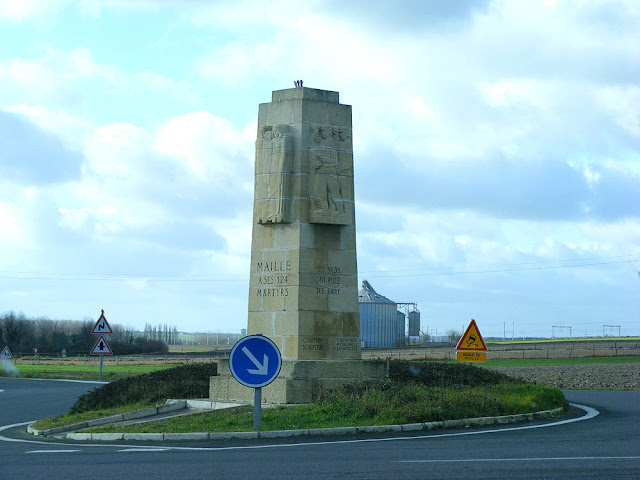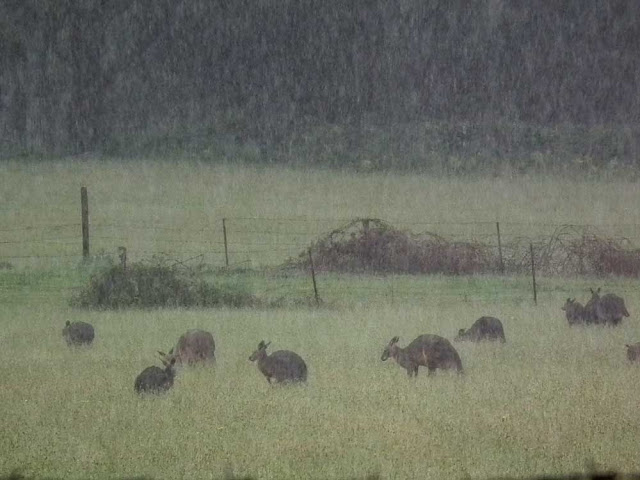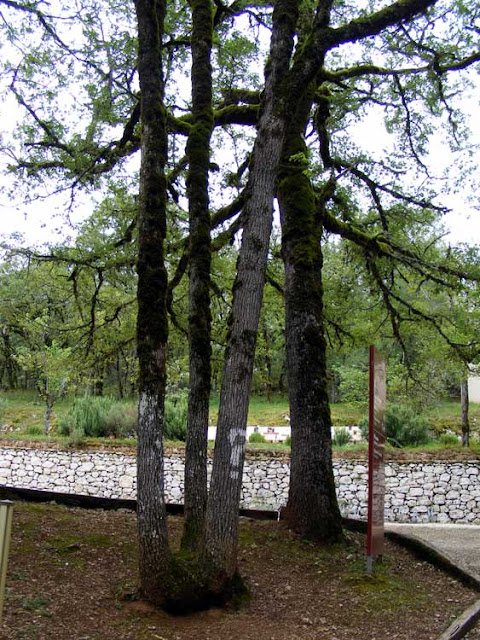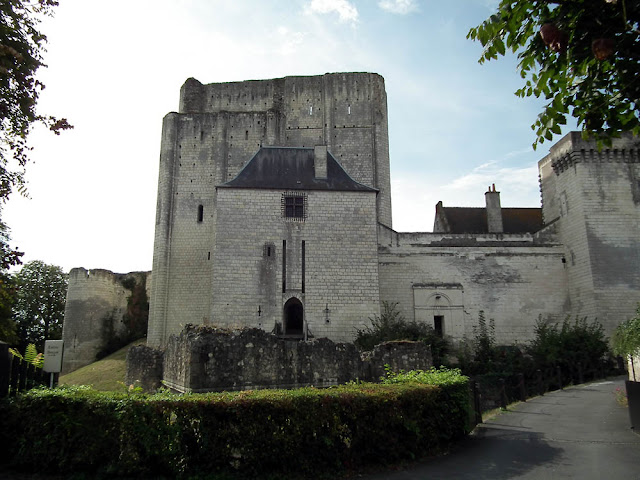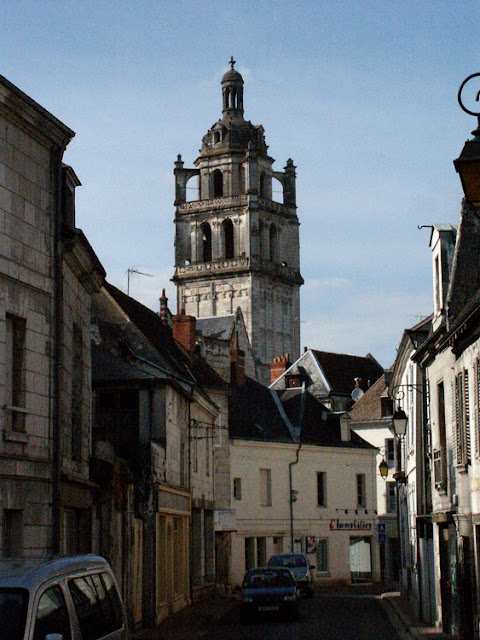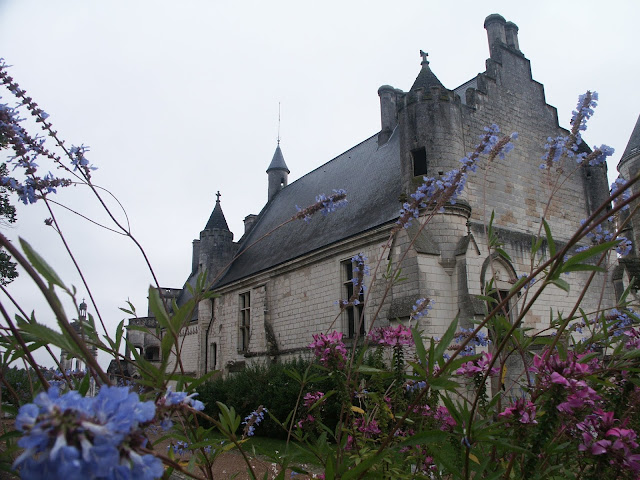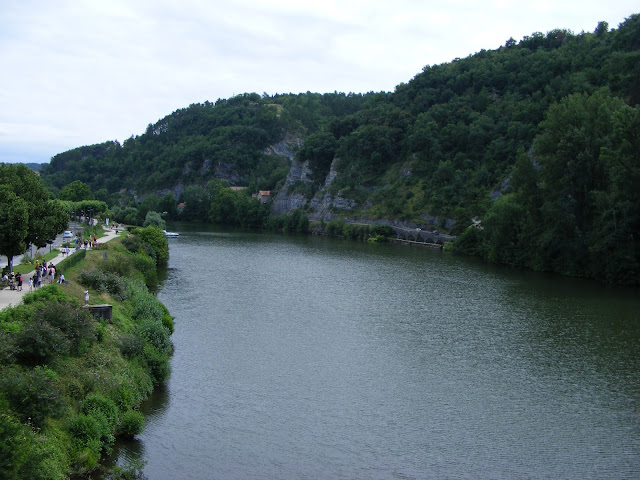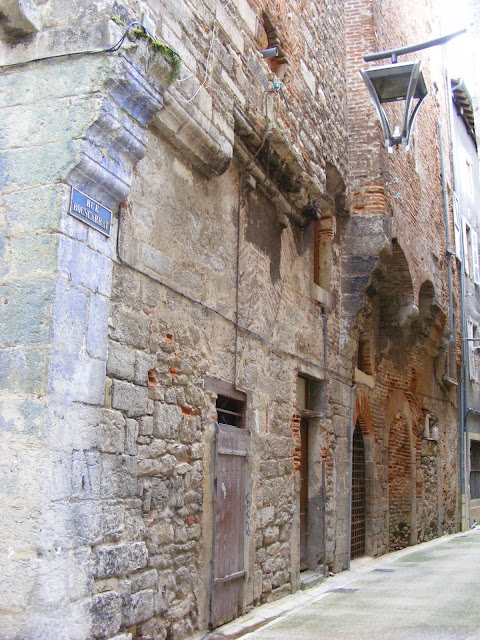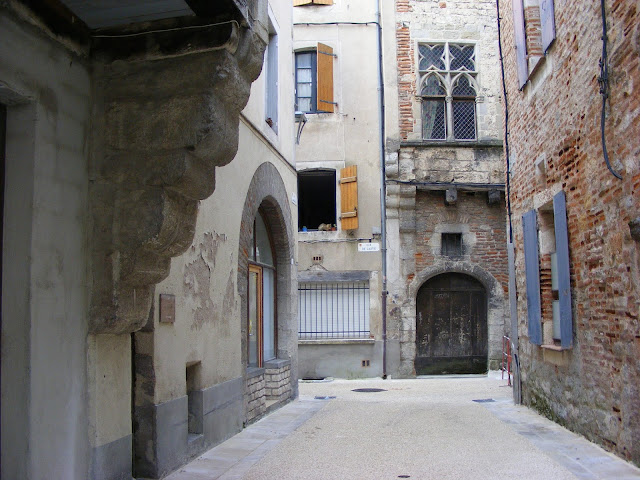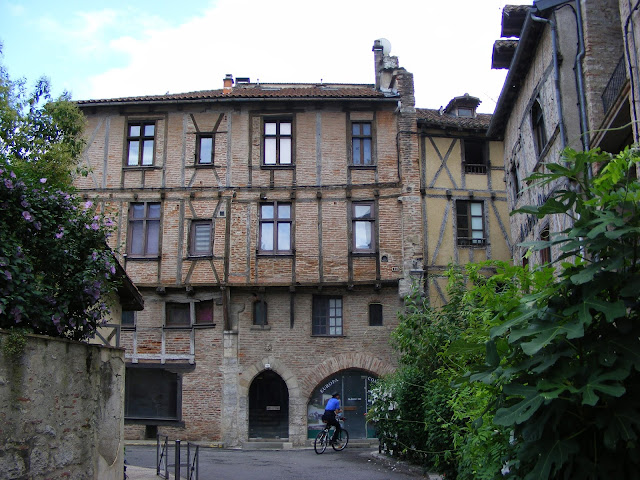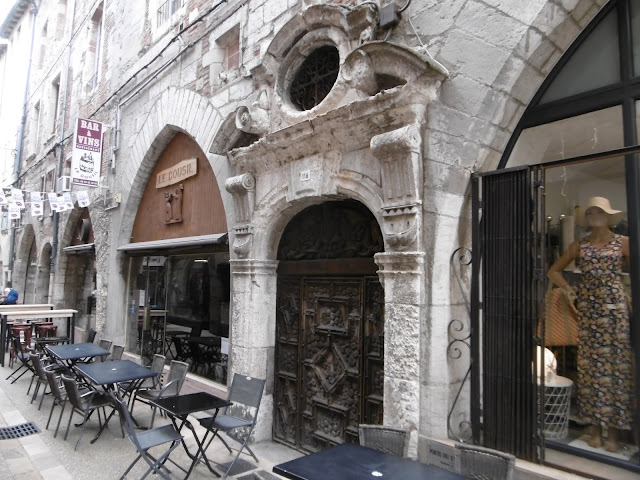...and some comments on how the locals do it, so you can emulate them if you want...
 |
Remains of the amuses bouches (pre-lunch nibbles) at Le Clos aux Roses in Chédigny.
|
These are my personal tips for dining in France, with the benefit of having lived here, in the Loire Valley, for more than a decade. Other people may approach it differently.
 |
Our local bakery.
|
Breakfast: If your accommodation has breakfast included, take advantage of that and eat your fill. If breakfast is extra then I suggest you go out and find a café or bar. If you just order a coffee (café) you will be served an espresso. If you want something other than an espresso you need to be specific about it eg if you want a coffee with milk in a larger cup, order a café grand creme (the term 'café au lait' will also be understood, but 'latte' will not). Not all cafés serve pastries (properly called viennoiseries). If they don't they will direct you to the nearest boulangerie (bakery) for you to buy something there that you bring back to your table and consume in the café. Expect to spend about €3 - €5 per head all up.
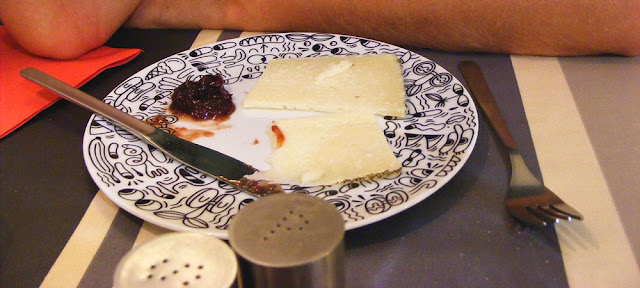 |
Local sheeps milk cheese and black cherry jam in a restaurant in Saint Jean de Luz, Pyrénées-Atlantique.
|
Lunch: The main meal of the day in France, and strictly 12.30 pm to 1.30 pm. If you arrive earlier you may get to sit around for a while because they are not quite ready to receive customers. If you arrive later than 1.30 pm most places will turn you away saying service has finished. If you have had lunch in an establishment there is no problem with lingering beyond 1.30 pm, especially on a Sunday. My advice is to do as the French do and make lunch your main meal in a restaurant. Lunch is cheaper than dinner. Many restaurants do an a la carte menu (known as 'la carte') and a daily changing limited choice 2 - 4 course fixed price menu (known as 'le menu' or 'la formule'). My advice is to always choose 'le menu' as it will be seasonal and what the chef wants to prepare on the day, and easily the best value.
The daily changing menu will usually consist of a choice of a couple of entrées (starters), a choice of 2-3 mains (sometimes, and increasingly, one of the choices will be vegetarian), cheese (often from a shared cheese platter with 2 - 6 cheeses that does the rounds of the restaurant), and a couple of choices of dessert (very often one fruit based, one dairy based).
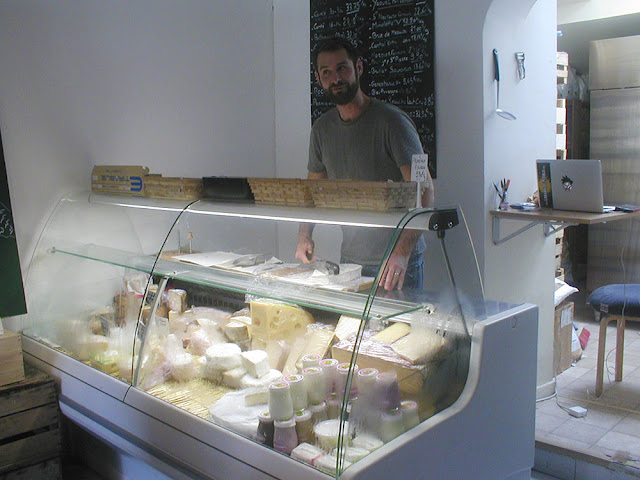 |
Our friend Charles at the cheese counter of his grocery store in Esves sur Indre.
|
French diners do not spend a long time agonising over what they will choose to eat. Mostly they will opt for 'le menu', trusting the chef to produce something delicious and balanced. This difference in time spent choosing what you eat between local French diners and foreign anglophone diners is really noticeable, and is a cultural difference that I suspect drives French waiters nuts because from their point of view it is inexplicably time wasting. Requesting dishes on the menu but with some element changed will also be viewed as peculiar and time wasting.
 |
Local oysters and prawns on Ile de Ré, with chardonnay wine from just across the water on the mainland.
|
Do not expect your coffee to come with your dessert. Even if your French is good enough to indicate you would like your coffee served with your dessert, it will most likely not happen. It disrupts the rhythm of the waiter's work, and again, is seen as such a peculiar request that they can't believe that's what you really meant, so won't do it. If you are happy with espresso you could order a café gourmand for dessert, which is a small platter with an espresso and three different mini desserts. If you want a coffee other than an espresso, see the section on Breakfast and how to order. You can also ask for a larger black coffee (café allongé will be the closest to a filter coffee). Decaffeinated coffee is widely available. Artificial sweeteners are not, so remember to bring your own.
 |
Cheese platter at Le Relais d'Azay sur Indre.
|
Wine, beer and a limited choice of non-alcoholic drinks will be offered. The house wine will almost always be good, and the best value. You may be asked if you would like an aperitif, which typically might be a glass of bubbly, or a kir (white wine with a dash of blackcurrant liqueur). There is no need to buy bottled water. By law you must be provided with a basket of bread and a carafe of tap water, although occasionally you may have to remind the waiter to bring the water.
 |
Roast pork and stir-fried vegetables by our chef friend Fréd at his old restaurant.
|
Look out for 'workers restaurants' who cater for ordinary working folk who eat lunch in a restaurant every day. These are often not open on the weekends or in August, but the good advice you will often hear is to look out for the white vans gathered in the car park of a restaurant by about 12.15 pm. That's a sure sign it's a good workers restaurant, serving hearty traditional meals to tradesmen and labourers. The establishments catering for office workers tend to be a bit more sophisticated and located in the centre of towns, rather than on main roads where there is space for large car parks. You may find you are the only anglophones in workers restaurants.
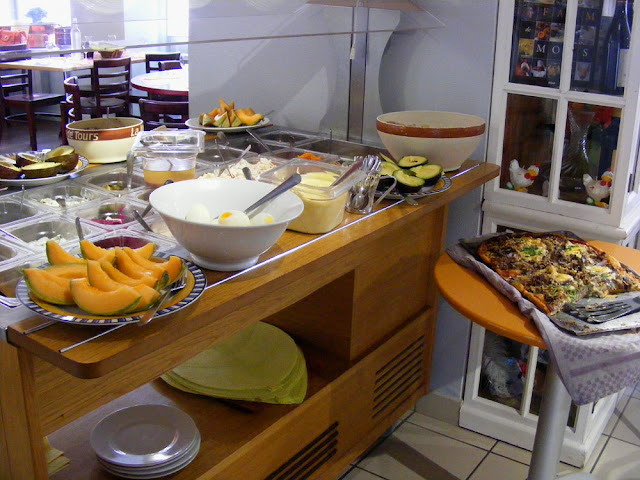 |
Starters buffet at Le Relais d'Azay sur Indre.
|
Typically at workers restaurants you would walk in and ask for a table (or say you have a reservation) and you'll be seated -- so far so regular. The menu du jour will often be on a board, sometimes you will be handed individual menus to choose from, usually the waiter will arrive and run through the menu then ask what you want to order. Be ready to say how you want your steak done if that's on the menu. You may also be asked what sauce you want with steak, and whether you want chips/fries (frites), salade (dressed lettuce) or vegetables. Usually all they are interested in is what you want for main course and what you want to drink with the meal. Often the starters are a buffet, so once your order is taken, you get up and serve yourself from the buffet. Don't take too much, as the main is likely to be generous. The waiter will come back to clear away your starter plates, but your cutlery will be left on the table and you use it for the main too. The main will be served, then cleared, including the cutlery. You may be offered a cheese course. If you are having cheese the waiter will get the platter of cheeses from whichever table currently has it and pass it on to you. You cut yourself about 3 small pieces of cheese each and the waiter will come back and move the cheese platter on to the next diners who are ready for it. When the cheese is cleared the waiter will ask what your dessert choice is. When the waiter clears dessert they will ask if you want coffee. The whole process is set up so that the meal will take an hour to an hour and a half.
 |
Owners Chef Armande and front of house Julien, Le Clos aux Roses, Chédigny.
|
Expect to spend about €20 - €25 per head for the menu du jour plus coffee and a glass of wine. When you want to pay and leave, simply get up and go to the cash register. Most people don't tip in workers restaurants, but you can leave a few coins on the table (€2 - €3).
 |
The wisteria covered terrace of Le Clos aux Roses, Chédigny.
|
Booking is not essential in most cases, but is appreciated (likewise, if you book and then can't make it, cancelling is appreciated). Many workers restaurants do not have websites (so they don't appear on popular online platforms such as The Fork/La Fourchette) or email addresses, and some only do lunch service. Booking is mostly done by phone, but diners often just walk in.
 |
Our friend Chef Fréd, in his old minuscule restaurant kitchen in Azay le Rideau.
|
Dinner: For the locals eating at home this would normally be quite a light meal -- a salad, some soup, a bit of cheese. Eating out at night tends to be for a celebration, so a bit special. This leaves anglophone travellers with a few issues -- restaurants don't open until later than some travellers would normally dine; dinner is more expensive; and it's more food that travellers really want to eat.
 |
Restaurant interior, Azay le Rideau.
|
One solution, if you are here when the days are long and the weather fine, is to picnic -- buy a baguette, some charcuterie, some cheese, some of those beautiful patisseries that you've been eyeing off in the bakers all day and a bottle of wine, and find a nice spot to sit and eat. Don't forget to pack travel cutlery, a couple of acrylic tumblers, a corkscrew and paper towel if you are going to go down this route.
If you dine in a restaurant my advice is not to get sucked in to having another three course meal if you already had one at lunch. It will be too much food and a waste of a delicious experience. Just opt for a single course or whatever looks lightest. Choose from 'la carte' for this meal because it will have a wider range. This will save you money and save you from an uncomfortable night with too full a belly. You will thank me in the morning 🙂
 |
Menu board.
|
Don't turn up at the restaurant before 7.30 pm because they probably won't be ready for you and might not even be open. When you want to leave, ask the waiter for 'l'addition'. You will be sitting there a long time if you don't ask for the bill, as the waiter will assume you are lingering by choice and will politely let you do so without interruption. Booking is expected, although you can get away with not doing so in most places. Restaurants that open for dinner usually do have websites, email addresses and sometimes even online booking systems. Usually, someone on the restaurant staff will speak at least some basic English.
 |
Our friend Sandrine, manning front of house at her and husband Fréd's old restaurant in Azay le Rideau.
|
Expect to spend maybe €10 - €15 per person if you picnic; and about €20 - €25 per person for a main course and a drink in a restaurant. Most people will tip somewhere between €2 and €10 for an evening meal for two.
 |
Creperie de Pontivy, near Montparnasse train station in Paris, one of several owned and run by Breton families who arrived in the 19th century.
|
Snacking: Generally the locals will avoid snacking, but kids are always offered a 4 pm snack, called le goûter -- usually a biscuit or two, a yoghurt, a piece of fruit or some chocolate or chocolate spread sandwiched in a piece of baguette, and a glass of water. There is no tradition of eating between meals or of eating multiple small meals at irregular hours. To be hungry is viewed as a good thing, making you appreciate the next meal all the more. French people don't obsess about being hydrated either, rarely drinking large mugs of hot liquid or cans of coke. If they are thirsty during the day they'll mostly have a small glass of water. If you do snack it is considered distinctly unclassy to do it on the hoof (ditto for drinking large milky takeaway coffees). The locals sit to eat or drink anything (or stand at a bar). English style tearooms are currently trendy, and these are probably your best bet for a mid-afternoon sit down and snack with a drink. Bars don't offer snacks and restaurants usually don't do continuous service (closing between lunch and dinner) and generally don't offer anything other than full meals. Your other option is somewhere like the cafeteria chain Flunch, associated with Auchan supermarkets. They serve everything from full cooked meals to the lightest of fruit or dairy snacks and drinks -- a real rarity in France, and amazingly inexpensive. (Don't bother trying to get the best deal by opting for one of their menus. They are incomprehensible, you will make a wrong choice and be charged more than you expected for sure. Just choose what you want, and it will cost at most a couple of euros more than the menus.)
 |
Le Garage in Saint Jean de Luz, Pyrénées-Atlantiques, an informal dining venue with multiple concession holders.
|
If you are used to grazing you can buy supplies of nuts, dried fruit, snack bars, chocolate, biscuits, fruit, crisps and so on in the supermarket, carry it with you, and find a nice bench to sit and consume it. But frankly, you'll spoil your dinner...
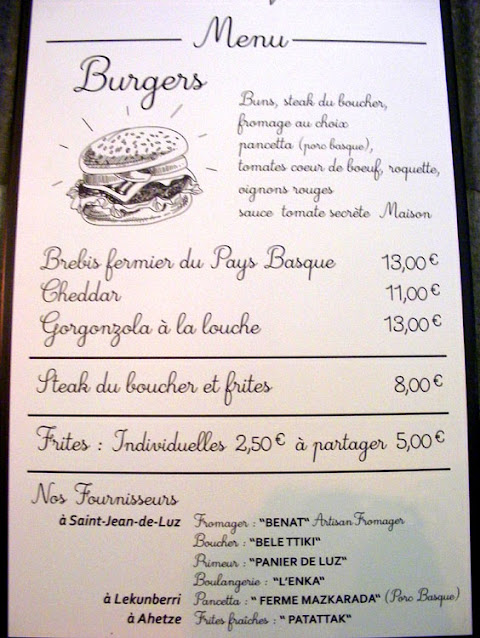 |
Burger menu at Le Garage, Saint Jean de Luz, Pyrénées-Atlantiques.
|
Apéro: There is a strong tradition of gathering for a pre-dinner drink. If it is at home it will often be with friends and include a range of nibbles, sometimes very simple, sometimes quite elaborate. The older generation opt for drinks like pastis and pineau de Charentes, Suze, Lillet or sparkling wine (usually not champagne). Younger people will drink beer. Apéro is usually about 6 pm and typically lasts about an hour -- enough time for a chat, a single drink and a few morsels of some simple nibbly thing (one tiny bowl per table of, for example, peanuts, olives, crisps). But as a form of home entertaining it can go on for several hours and be more like tapas, in which case it is known as apéro dînatoire.
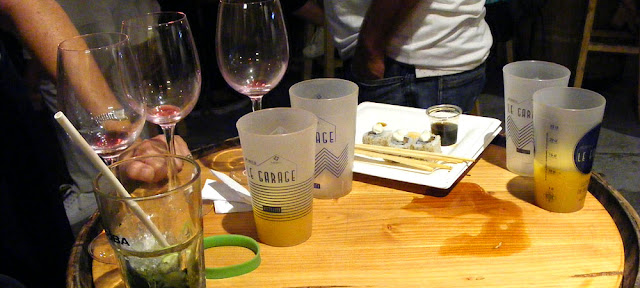 |
Drinks at Le Garage, Saint Jean de Luz, Pyrénées-Atlantiques.
|
Allergies: In general just say to waiters that you are allergic to something. They will take it seriously and advise you accurately what you can and can't eat on the menu. Say 'je suis allergique à fruits aux coque (nuts)/produits laitiers (dairy)/gluten'.
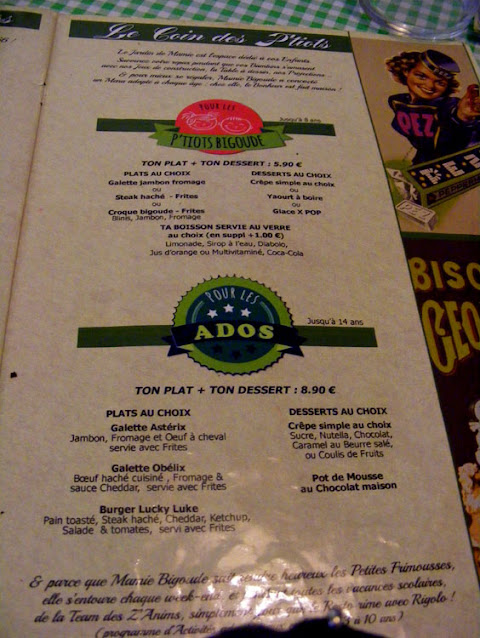 |
Kids menu at Mamie Bigoude restaurant, Chambray les Tours.
|
Restaurant staff are properly clued up about coeliac disease and will make sure you are as safe as possible. It doesn't hurt to ask if you are unsure about a sauce or some other aspect of a dish. However, no regular French restaurant can guarantee gluten free dishes. There is bread everywhere and always the possibility of inadvertent cross contamination. Do not say you are coeliac, instead say you are allergic to gluten -- that will be better understood. My brother-in-law is coeliac and I've never had any trouble getting him suitable food. He did tell me that it is much harder when he has to negotiate it on his own, with no French. For a limited selection of GF products, go to the Diététique (health food) section of the supermarket (Australians and anyone else from somewhere that GF is generously catered for as standard -- you are in for a shock!)
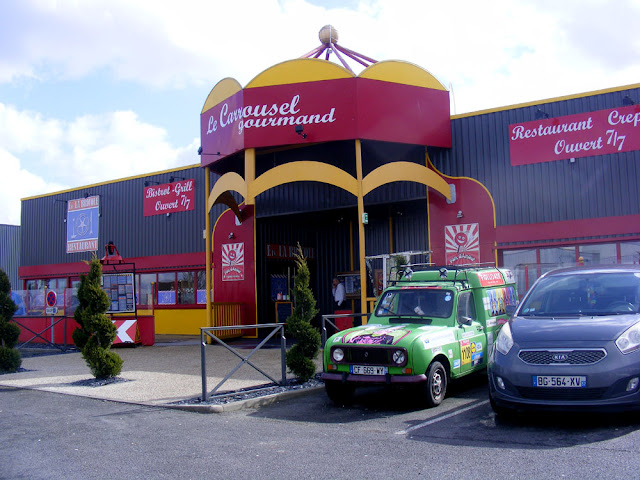 |
The quirky and informal Mamie Bigoude restaurant in Chambray les Tours.
|
Just about everything in the North has butter in it. In central and south-western France the fats of choice are lard and duck, but butter is still used quite a lot. In the South it is much more olive oil. French cuisine is much less cream laden that decades ago. I've had the occasional lactose intolerant client and they have always been OK, often just by judiciously choosing dishes for themselves off la carte that they would expect to be low dairy or dairy free. Don't expect to encounter milk substitutes in cafés and restaurants. The very occasional trendy coffee shop in Paris might have soy milk, but that's about it. Places in the provinces won't have it, although you can buy it and almond and oat milk in every supermarket now, and dairy free yoghurt. Plus sorbets are a popular and widely available alternative to
ice cream. There won't be any vegan cheese anywhere, but you can get non-dairy butter substitutes in any supermarket.
Young American medical students on one of our tours, enjoying an Epiphany tradition at a workers restaurant near Chenonceau.



























